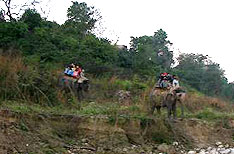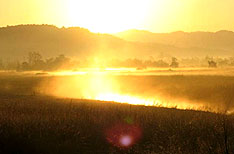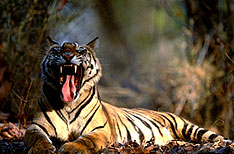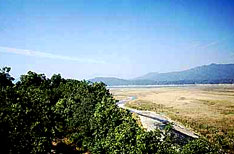 |
  Home | Contact | Site Map |

| Top Destinations |
|
You are here Home » Top Destinations » Corbett Uttaranchal
Honeymoon in Corbett, Uttaranchal, India  About Corbett Named after Jim Corbett, the legendary hunter naturalist, the Corbett National Park, is believed to be one of the finest habitats of the tiger in India. Nestled in the foothills of the Himalayas, the park extends over a tract of 520 sq. km. A large valley with forested ridges, the Ramganga River winds through its entire length and dense sal and deciduous forests cover the park area. Over 50 mammals, 580 birds and 25 reptile species have been listed in Corbett, but it is most famous for the ever-elusive Tiger. The National Park was set up in 1973 and chosen for Project Tiger, of the World Wildlife Fund. Wildlife population includes Elephants, the Leopard and smaller Cats, Sambar; Chital the beautiful spotted Deer, Barking deer, Wild Boar, Sloth and Himalayan Black Bear and Crocodiles. HISTORYEstablished as the first national park of India, on 6th August 1936, it was renamed in 1957 as Corbett National Park, in memory of Jim Corbett, the legendary hunter and naturalist. With the launching of Project Tiger in 1973, the Corbett National Park was selected as one of the nine tiger reserves. A major landmark in the field of wildlife preservation, Corbett is no doubt one of India's most picturesque and best-known National Parks. While the area of the national park was increased in 1966, to enhance its integrity, there are proposals, to enlarge the national park through the establishment of a wildlife sanctuary, and to establish a corridor of protected areas between Corbett and the proposed Rajaji National Park in the northwest. CULTUREPatli Dun was formerly part of the princely state of Tehri Garhwal. At that time, its forests were cleared to make the area less vulnerable to attacks from the Rohilas. Later, the Raja of Tehri, ceded part of his state to the British, in return for their assistance in driving out the Gurkhas. Boksas, tribals from the terai, settled in the area and practiced shifting cultivation, but they were evicted in the early 1860s under Major Ramsay. There are no settlements within the national park. About 7-8 villages on the boundary have grazing rights inside the national park. A large settlement has been established at Kalagarh under the Ramganga Dam project. SHOPPINGSouvenirsSouvenirs are available at various places in the park. The best places for purchasing these are however located at the main gates. The shop at the Amdanda gate is located just outside the park boundary, whereas the one at Dhangari is located inside. These souvenirs include items like t-shirts, caps, ashtrays, postcards, key chains etc. Souvenirs are also occasionally available at the Dhikala reception office and restaurants. GroceriesThe local restaurant (Dhaba) at Dhikala is well stocked with most vegetables, Maggie noodle packets, snacks, mineral water, soft drinks, toiletries and other essential and important items. It is also possible to get some food packed from here if you are staying at one of the other forest rest houses which do not offer the facility of a restaurant. Film RollsAlthough it is advisable to carry enough film rolls before entering the park but if required, these can be purchased from the shops at the main entrance and also at the restaurant / grocery shop at Dhikala. Availability of film at these shops is never a guarantee. FOODA buffet breakfast consists of hash browns, baked beans, a fluffy 'masala omlette' or an egg of your choice. Toast, butter, marmalade and a pitcher of tea, coffee, or juice are regular features. For those who have Indian tastes, try the chola-bhatura, poha or something as tantalisingly spiced! Lunch and dinner are served buffet-style with a wide range of items to chose from like mutton rogan josh, paneer butter masala and sweet finales with gulab jamuns or kheer. ENTERTAINMENTFor people interested in specific animals, the following tips may be of some help as to where to look for them. However, it must be kept in mind that this is a jungle and is a home without boundaries to all the animals that live in it. The fact that the chances of seeing specific animals in the areas mentioned below are higher, there is no guarantee where they may show up during your visit. So, keep these tips in mind but also follow your own and your guide's instincts.These tips could also help you knowing the best spots in case your guide doesn't take you there. Tigers: Sambar Trail, Gettheryo, Main road between High Bank and Ram Singh Road, Dhikala to Paterpani road, Bijrani to Malani jungle road. Elephants: Jungle track between Sultan and Gairal, Dhikala and Khinanauli chaurs, Mota sal, Champion Road and surrounding area, all sots towards late evening, from Dhikala watchtower, Gairal Forest Rest House, Sambar Trail, Gettheryo and Ram Singh Road. If visiting the park in the summers, it is almost impossible to return without seeing elephants at any, or all, of these places. Deer: Dhikala and Khinanauli chaurs, Jamun Bhuji, Gettheryo, Amla Sot and Sambar Trail. Wild Boar: Dhikala and Khinanauli chaurs, Jamun Bhuji, Nimbu bhuji, Roads leading down to Gairal. Jackals: Sarapduli, Gairal huts. Leopards: Northern Ridge and above Ram Singh Road. Otters: Near opposite banks of the river Ramganga below Khinanauli, Champion Road. Porcupines: Around Forest rest House dumps and near kitchen windows (at night) Ghoral: Northern ridge Crocodiles: Crocodile Pool, End of Champion road, Ramganga Reservoir, River bank between Gairal and Crocodile Pool. Turtles: In shallow waterholes and pools. Sal Tortoises: Waterholes and around decaying kills. Dhole: Bijrani / Malani area (extremely rare). Himalayan Black Bear: Northern Ridge Sloth Bear: Bijrani / Malani area Birds: Riverbeds, Ramganga Reservoir, in and around chaurs, from Dhikala watchtower, Lower southern reaches of the northern ridge opposite Khinanauli. General Information of Corbett LOCATION260 km from Delhi, on the banks of the River Kosi, approximately 4 km from the Dhangarhi entrance of Corbett National Park and 12 km from the nearest railway station (Ramnagar). How to Reach By AirThe nearest airport is at Pantnagar, 85-km away from the resort. Flights from here are not currently operational. By RailRamnagar, the nearest railhead is 12 km from the resort. The Ranikhet Express plies between Delhi and Ramnagar, departing from Delhi at 10.50 pm arrives at 4.35 am. The train from here for Delhi begins at 9.05 pm, reaching Delhi at 5 am. There are no air-conditioned coaches from Delhi to Ramnagar but First Class coupes are available (Rs 350). Return tickets have to be booked on reaching Ramnagar. The nearest meter gauge railhead is at Haldwani. By RoadMost people prefer to drive down to The Claridges Corbett Hideaway. It takes approximately six hours from Delhi to cover the 260-km stretch dotted with petrol pumps and dhabas. The road is reasonably good, though it is best not to travel during the monsoons. The route takes you through Gajraula (you must sample a thali at the Bhajan Dhaba here), Moradabad, Kashipur and Ramnagar. Basant Continental and Midway Motels at Gajraula are recommended stoppage points. Buses from Delhi depart for Ramnagar from ISBT Anand Vihar. the ticket costs Rs 108. No deluxe buses are available. Deluxe buses are available to Haldwani and you can hire a car from here to the resort. Buses depart regularly from Ramnagar to Delhi, between 5 am and 8 pm each day. The ticket cost is roughly the same. CLIMATEMinimum temperature of 8? C and a maximum of 25? C between November and end-March. Temperatures range between a minimum of 15? C and 38? C from April to end-October. Monsoons hit the region between July and September and the roads are not motorable during these months. Tourist Attractions in Corbett Corbett National Park  This first national park of India was named after the Anglo-Indian hunter of man-eating tigers and leopards, who became a conservationist. Opt for dawn and dusk elephant safaris through dense forests, some on steep slopes, swift-flowing rivers, and grassy plains stretching between the Garhwal and Kumaon Shivalik ranges. You might spot a tiger, though they're nocturnal creatures, and see herds of wild elephant resting like charcoal grey boulders. There are also long snorted, fish-eating gharial crocodiles and their heavier cousins, the mugger; plenty of sambar, chital, hog and barking deer. More than 400 species of birds inhabit the park. Dhikala
|
 At the heart of the core area, where the tourist complex is situated, is a favorite viewing area. It is located at the edge of a grassy plateau, and perches high above the Ramganga reservoir. Deer and wild boar fearlessly roam in the compounds.
At the heart of the core area, where the tourist complex is situated, is a favorite viewing area. It is located at the edge of a grassy plateau, and perches high above the Ramganga reservoir. Deer and wild boar fearlessly roam in the compounds.